|
Week 7: September 12 - 18, 2009 |
Welcome
to the McGill Bird Observatory weekly report.
Click here for a complete listing of our archives.
Comments or
questions are welcome at "mbo AT migrationresearch.org".
|
PICTURE
OF THE WEEK: |
|
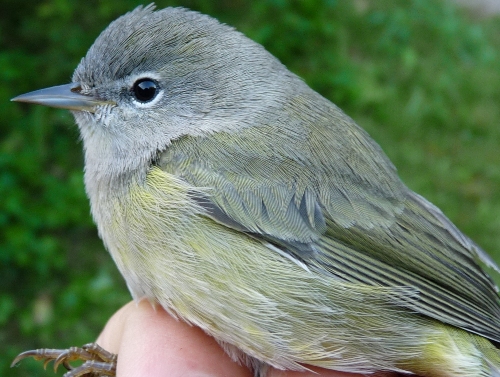
This Orange-crowned Warbler was the first of its kind banded at MBO this year. Among
the least common warblers here, we band on average fewer than 10 individuals annually.
This species is often mistaken for others, including Tennessee Warbler, Philadelphia
Vireo, and Ruby-crowned Kinglet. However, the combination of a slender bill, yellow
undertail, and grayish head is enough to identify it correctly, even when there is no
orange visible on the crown, as on this hatch-year female.
(Photo by Marcel Gahbauer)

|
MBO
gratefully acknowledges the financial support
provided for the 2009 Fall Migration Monitoring
Program by TD Friends of the Environment Foundation
|
|
|
|
THIS WEEK |
THIS FALL |
2009 TOTAL |
SITE TOTAL |
|
# birds (and species) banded |
185 (38) |
1209 (64) |
2213 (81) |
21134 (105) |
|
# birds (and species) repeat |
29 (10) |
237 (28) |
516 (42) |
3863 (66) |
|
# birds (and species) return |
1 (1) |
26 (16) |
144 (32) |
598 (37) |
|
# species observed |
71 |
120 |
159 |
198 |
|
# net hours |
504.0 |
3577.0 |
6935.5 |
37400.8 |
|
# birds banded / 100 net hours |
36.7 |
33.8 |
31.8 |
56.5 |
|
|
Note: table does not include nocturnal banding (owls) |
|
Banders-in-charge: Simon Duval, Marcel Gahbauer, Gay Gruner
Assistants: Josiane Alarie, Veronica Aponte, Christine Barrie, Jean Beaudreault, Catherine Doucet, Tiffany Gilchrist, Jeff Harrison, Marie-Anne Hudson, Kristen Keyes, Gabrielle Laurent, Francine Marcoux, Chris Murphy, Alex Stone, Rodger Titman, Carine Touma
Notes: The first day of this week started much like last week ended, with just a trickle of birds banded, and the last morning of the week was largely lost to rain and very gusty winds. In between, however, results were more encouraging than the past couple of weeks, with an average of 35 birds banded each morning. That's still somewhat below average for this time of year, but the increasing number of sparrows as the week progressed bodes well for next week.
Among the birds we did catch this week were two species banded for the first time this year (Black-billed Cuckoo and Orange-crowned Warbler) plus another three banded for the first time this fall (Blue-headed Vireo, Ruby-crowned Kinglet, and Lincoln's Sparrow). The Lincoln's Sparrow was also one of four species observed for the first time this fall, the others being Snow Goose, Slate-colored Junco, and Clay-colored Sparrow. The latter was the highlight of Thursday morning's census, and only the second record for MBO.
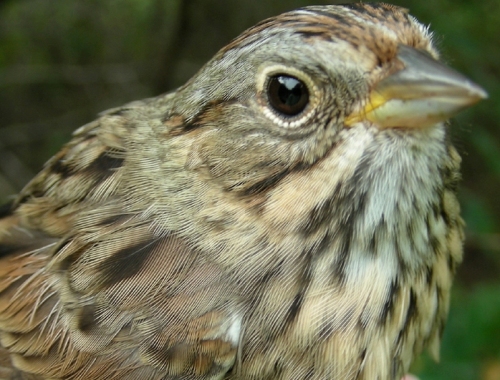
We have been enjoying an above average movement of Song Sparrows this fall, so when this elegant Lincoln's Sparrow paid us a visit this week it immediately jumped out as something different.
(Photo by Gay Gruner)
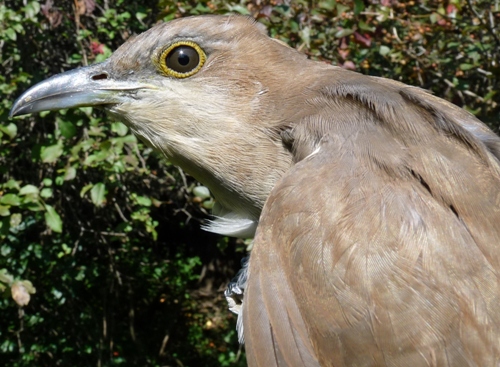
Cuckoos are always a rare treat at MBO, with only six in total banded to date. Last fall we banded two of them, but in every previous year we have caught only a single bird (a Yellow-billed in 2005, and a Black-billed in each of 2006 and 2007). The young Black-billed Cuckoo above almost escaped us - it actually did fly out of the first net it landed in, but in trying to get away flew right into a perpendicular net and was bagged before being able to make another attempt to get away.
(Photos by Marcel Gahbauer)
|
To our surprise, Song Sparrows have returned to the top of the list of species banded for the week, the fifth time they've occupied that position in this fall's seven weeks to date! Previously we had never banded more than 23 Song Sparrows in week 7, so all signs point toward Song Sparrows being one of relatively few species that appear to have had an unusually productive breeding season this summer. White-throated Sparrows, typically the more abundant sparrow at this time of year, slipped down to second place; interestingly they were observed in much larger numbers than Song Sparrows this week, indicating that either they were less likely to find the nets, or (more probably) the Song Sparrows were quieter and undercounted due to being less conspicuous. Nashville Warblers have been remarkably scarce this fall, so their appearance in fourth place is a welcome surprise at this point. Indigo Buntings remain unusually common for this time of year, with more banded over the past three weeks than in some entire fall seasons. The remainder of the top ten is rounded out with small numbers of a variety of relatively common species.
This week’s top 10 [last week's rank in brackets]
# individuals banded |
mean # individuals observed daily |
1. Song Sparrow (34) [2] |
1. Canada Goose (80.6) [1] |
2. White-throated Sparrow (31) [1] |
2. European Starling (25.1) [-] |
3. Magnolia Warbler (12) [2] |
3. American Robin (24.7) [8] |
4. Nashville Warbler (10) [-] |
4. Cedar Waxwing (24.0) [3] |
4. Indigo Bunting (10) [5] |
5. American Crow (21.0) [2] |
6. Blackpoll Warbler (7) [10] |
6. White-throated Sparrow (18.9) [9] |
6. Common Yellowthroat (7) [4] |
7. Black-capped Chickadee (18.7) [4] |
6. Swamp Sparrow (7) [-] |
8. American Goldfinch (18.3) [6] |
10. Black-capped Chickadee (5) [9] |
9. Blue Jay (16.7) [7] |
10. Gray Catbird (5) [-]
10. Tennessee Warbler (5) [-]
10. Lincoln's Sparrow (5) [-]
|
10. Red-winged Blackbird (15.3) [-] |
|
Again this week the average number of Canada Geese increased, giving them a commanding lead over all other species on the list of birds observed. Thanks to a few large flocks passing overhead, European Starling made a rare appearance on the list, all the way up in second place. Smaller flocks of Red-winged Blackbirds appeared this week; they and the starlings bumped Common Grackle and Song Sparrow off the list. Although it is still relatively early in the season, American Robins are already building in numbers. American Crow and Cedar Waxwing were similar in abundance to last week, while Black-capped Chickadees have dipped a bit, but we suspect there may be another wave of migrants yet to come.
|
For a second straight week we felt at times like our theme was the colour blue. In addition to a surprising number of Indigo Buntings, we had the following species visit us in the nets:
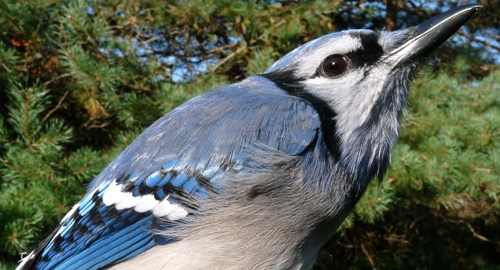
Blue Jays were quite active at MBO this week, at times haranguing Sharp-shinned or Cooper's Hawks, and other times just moving about in small, noisy flocks.
(Photo by Marcel Gahbauer)
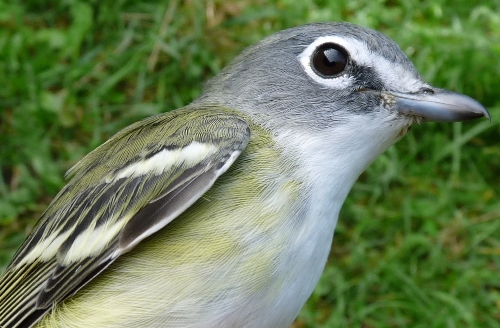
Sunday morning's highlight was this Blue-headed Vireo, at long last our first one banded this fall. Later in the week two were heard singing, a rare sound at MBO in fall.
(Photo by Marcel Gahbauer)
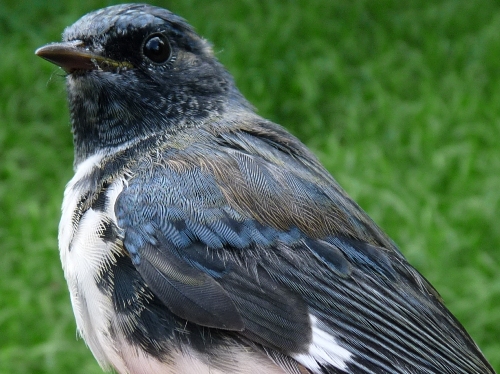
Black-throated Blue Warblers are striking birds, but like any others they can look quite scruffy when moulting. This young male is just in the process of replacing his greater coverts (visible growing in, with broad blue edges) and still has quite a bit of brown on the back.
(Photo by Marcel Gahbauer)
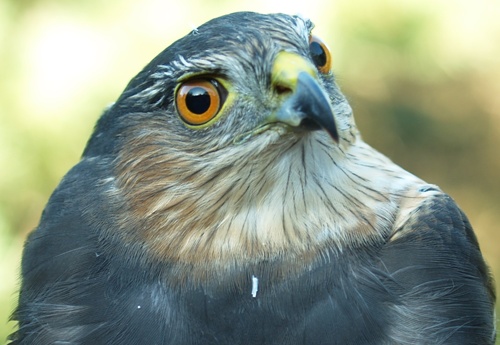
Okay, so a Sharp-shinned Hawk may not quite be a "blue" bird - but a second-year individual like the female above does have a rather blue-gray back. Usually almost all of the sharpies we catch are young birds, so it was a special opportunity to examine the plumage of an older bird for a change.
(Photo by Simon Duval)
|








